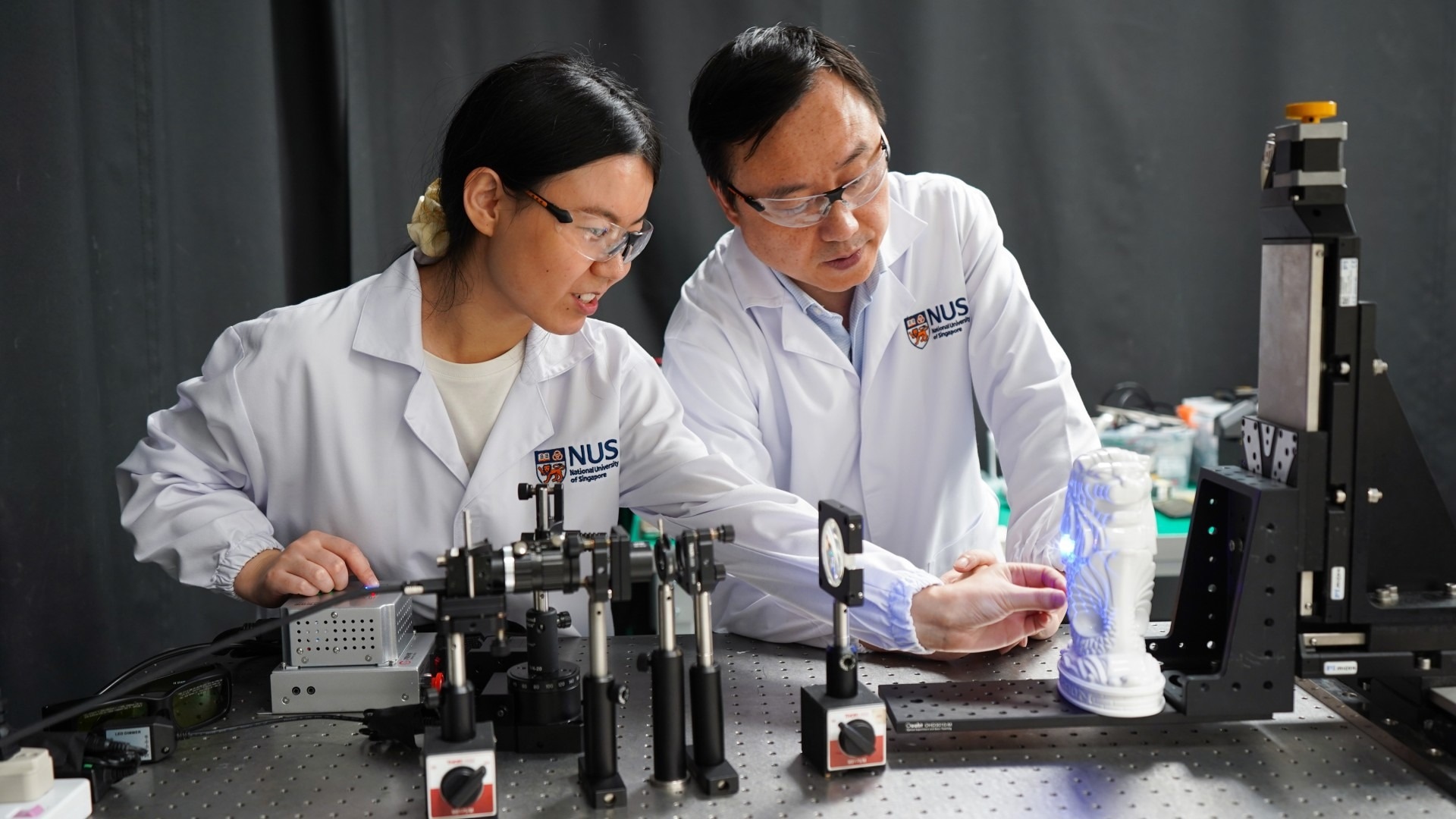A study group from the National University of Singapore (NUS) Faculty of Science, headed by Professor Liu Xiaogang from the Department of Chemistry, has built a 3D imaging sensor.

Prof Liu Xiaogang (right) and Dr Yi Luying from the NUS Department of Chemistry capturing a 3D image of a model using the light-field sensor. Image Credit: National University of Singapore
The sensor has a highly great angular resolution, which is the ability of an optical instrument to categorize points of an object distinguished by a small angular distance of 0.0018o. This advanced sensor functions on a unique angle-to-color conversion principle, which enables it to sense 3D light fields through the X-ray to the visible light spectrum.
A light field covers the integrated direction and intensity of light rays, which the human eyes can process to accurately sense the spatial relationship among objects. However, conventional light sensing technologies are less efficient. For instance, a majority of cameras can only create 2D images, which is sufficient for usual photography but inadequate for more cutting-edge applications, which include self-driving cars, virtual reality, and biological imaging. Such applications need accurate 3D scene construction of a specific space.
For instance, self-driving cars have the potential to utilize light-field sensing to see streets and, more precisely, test road hazards so as to tune their speed accordingly. Also, light-field sensing could facilitate surgeons to precisely image the anatomy of a patient at different depths, enabling them to make more accurate incisions and improve testing of a patient’s risk of injury.
Currently, light-field detectors use an array of lenses or photonic crystals to obtain multiple images of the same space from many different angles. However, integrating these elements into semiconductors for practical use is complicated and costly. Conventional technologies can detect light fields only in the ultraviolet to visible light wavelength range, leading to limited applicability in X-ray sensing.
Professor Liu Xiaogang, Department of Chemistry, National University of Singapore
Besides, when compared to other light-field sensors like microlens arrays, the light-field sensor of the NUS team has a higher angular measurement range of over 80°, a high angular resolution that can likely be below 0.015° for tinier sensors, and a broader spectral response range from 0.002 nm to 550 nm. At higher depth resolution, such specifications make the new sensor able enough to capture 3D images.
On May 10th, 2023, the discovery was published in the esteemed journal Nature.
Made Possible by Perovskite Nanocrystals
Inorganic perovskite nanocrystals are at the heart of the new light-field sensor, which are compounds that have outstanding optoelectronic properties. Owing to their controllable nanostructures, perovskite nanocrystals are successful light emitters with an excitation spectrum that covers X-Rays to visible light. By meticulously changing their chemical characteristics or by introducing tiny quantities of impurity atoms, the interactions between perovskite nanocrystals and light rays can also be adjusted.
Onto a transparent thin-film substrate, NUS scientists have patterned perovskite crystals and combined them into a color charge-coupled device (CCD), converting incoming light signals into a color-coded output. This crystal-converter system consists of a fundamental functional unit of the light-field sensor.
When the sensor is hit with the incident light, the nanocrystals get excited. As a result, the perovskite units release their own light in different colors based on the angle at which the incoming light ray strikes. The emitted color is captured by CCD, which can then be employed for 3D image reconstruction.
A single angle value, however, is not enough to determine the absolute position of the object in a three-dimensional space. We discovered that adding another basic crystal converter unit perpendicular to the first detector and combining it with a designed optical system could provide even more spatial information regarding the object in question.
Dr. Yi Luying, Research Fellow, Department of Chemistry, National University of Singapore
Then, they assessed their light-field sensor in proof-of-concept experiments and discovered that their approach could actually capture 3D images—with precise reconstructions of dimension and depth—of objects located 1.5 m away.
Their experiments also established the ability of the new light-field sensor to resolve finer details. For instance, an accurate image of a computer keyboard was developed that also captured the shallow protrusions of individual keys.
Future Research
Prof Liu and his research group are searching for approaches to enhance the spatial accuracy and resolution of their light-field sensor, like with the use of higher-end color detectors. They also applied for an international patent for the technology.
We will also explore more advanced technologies to pattern perovskite crystals more densely onto the transparent substrate, which could lead to better spatial resolution. Using materials other than perovskite may also expand the detection spectrum of the light-field sensor.
Professor Liu Xiaogang, Department of Chemistry, National University of Singapore
Journal Reference
Yi, L., et al. (2023). X-ray-to-visible light-field detection through pixelated colour conversion. Nature. doi.org/10.1038/s41586-023-05978-w.
Source: https://nus.edu.sg/